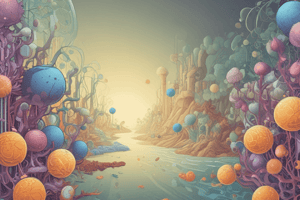Podcast
Questions and Answers
What is the characteristic of bacteria that distinguishes it from other microorganisms?
What is the characteristic of bacteria that distinguishes it from other microorganisms?
- Photosynthetic pigments
- Presence of mitochondria
- Absence of a nuclear membrane (correct)
- Rigid cell walls
Which of the following is a role of bacteria in human life?
Which of the following is a role of bacteria in human life?
- Causing diseases
- Weakening host immune defenses
- Aiding in digestion (correct)
- Producing photosynthetic pigments
What is the primary characteristic of fungi?
What is the primary characteristic of fungi?
- Rigid cell walls (correct)
- Presence of mitochondria
- Photosynthetic pigments
- Motility
What distinguishes fungi from bacteria?
What distinguishes fungi from bacteria?
Which type of microorganism contains DNA within a nuclear membrane?
Which type of microorganism contains DNA within a nuclear membrane?
What is the primary reason for most fungal infections in humans?
What is the primary reason for most fungal infections in humans?
Which of the following characteristics is common to all fungi?
Which of the following characteristics is common to all fungi?
What is the main mode of growth for most microalgae?
What is the main mode of growth for most microalgae?
Which characteristic defines viruses as infectious agents with non-living characteristics?
Which characteristic defines viruses as infectious agents with non-living characteristics?
What is a defining feature of protozoa?
What is a defining feature of protozoa?
What role do beneficial microbes play in biodegradation?
What role do beneficial microbes play in biodegradation?
What determines the pathogenicity of microorganisms?
What determines the pathogenicity of microorganisms?
How are Gram-positive and Gram-negative bacteria classified based on their cell wall structure?
How are Gram-positive and Gram-negative bacteria classified based on their cell wall structure?
What makes up around 90% of the dry weight of Gram-positive bacterial cell wall?
What makes up around 90% of the dry weight of Gram-positive bacterial cell wall?
What is the role of microorganisms in bioremediation?
What is the role of microorganisms in bioremediation?
What distinguishes cyanobacteria from other microalgae?
What distinguishes cyanobacteria from other microalgae?
Study Notes
Characteristics of Bacteria
- Bacteria are distinguished from other microorganisms by their prokaryotic cell structure, lacking a true nucleus and membrane-bound organelles.
- They possess a rigid cell wall mainly composed of peptidoglycan, which provides structural support.
Role of Bacteria in Human Life
- Bacteria play essential roles such as aiding digestion, synthesizing vitamins, and contributing to the immune system.
- Certain bacteria are utilized in food production (e.g., yogurt and cheese) and bioremediation processes.
Characteristics of Fungi
- Fungi are characterized by their eukaryotic cell structure, containing a defined nucleus and membrane-bound organelles.
- They possess a cell wall primarily made of chitin, differing from the peptidoglycan found in bacterial cell walls.
Distinction Between Fungi and Bacteria
- Fungi are distinct from bacteria due to their eukaryotic nature, multicellular or unicellular organization, and the presence of chitin in their cell walls.
Microorganisms with Nuclear Membrane
- Eukaryotic microorganisms, including fungi and protozoa, contain DNA within a nuclear membrane, distinguishing them from prokaryotes like bacteria.
Fungal Infections in Humans
- Most fungal infections in humans are attributed to opportunistic pathogens that exploit weakened immune systems or underlying health conditions.
Common Characteristics of All Fungi
- All fungi exhibit heterotrophic nutrition, absorbing nutrients from organic matter, and reproduce via spores.
Main Mode of Growth for Microalgae
- Microalgae predominantly grow through photosynthesis, utilizing light energy to convert carbon dioxide and water into organic compounds.
Virus Characteristics
- Viruses are defined as infectious agents that lack cellular structure, cannot reproduce independently, and are composed of genetic material encased in a protein coat.
Defining Features of Protozoa
- Protozoa are single-celled eukaryotic organisms characterized by their ability to move independently using cilia, flagella, or pseudopodia.
Role of Beneficial Microbes in Biodegradation
- Beneficial microbes aid in biodegradation by breaking down organic pollutants, thus facilitating the clean-up of contaminated environments.
Pathogenicity of Microorganisms
- The pathogenicity of microorganisms is determined by factors such as virulence, the ability to evade the host immune response, and the production of toxins.
Classification of Bacteria
- Gram-positive bacteria have a thick peptidoglycan layer in their cell wall, while Gram-negative bacteria possess a thinner layer with an outer membrane.
Composition of Gram-positive Bacterial Cell Wall
- The dry weight of Gram-positive bacterial cell walls is composed of approximately 90% peptidoglycan, providing structural integrity.
Role of Microorganisms in Bioremediation
- Microorganisms are utilized in bioremediation processes to degrade or detoxify environmental contaminants, helping to restore polluted ecosystems.
Distinction of Cyanobacteria
- Cyanobacteria differ from other microalgae by their ability to conduct photosynthesis while also fixing atmospheric nitrogen, contributing to nutrient cycling.
Studying That Suits You
Use AI to generate personalized quizzes and flashcards to suit your learning preferences.
Description
Explore the classification of microscopic organisms like bacteria, viruses, archaea, algae, fungi, and protozoa. Understand the types and characteristics of these microorganisms.




